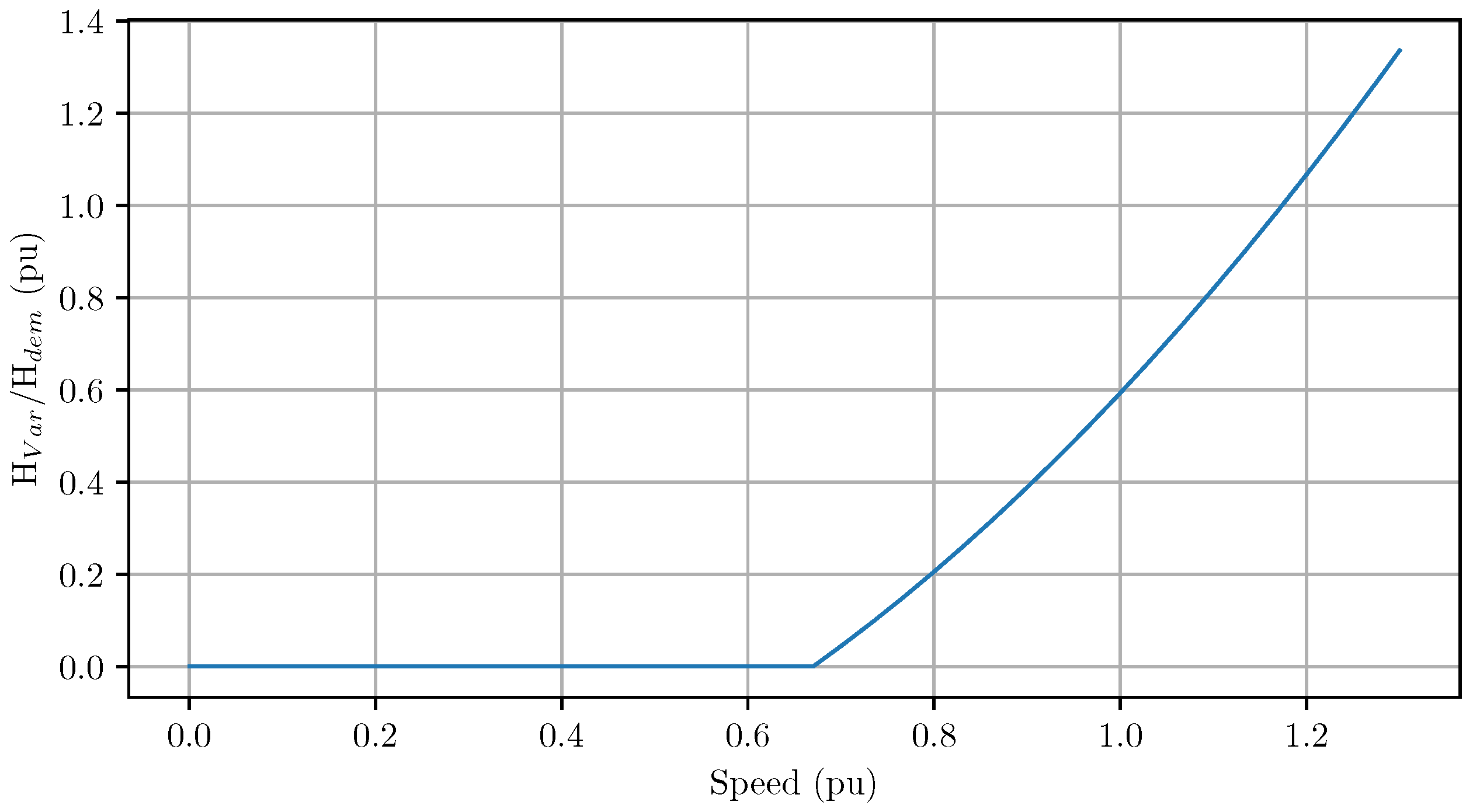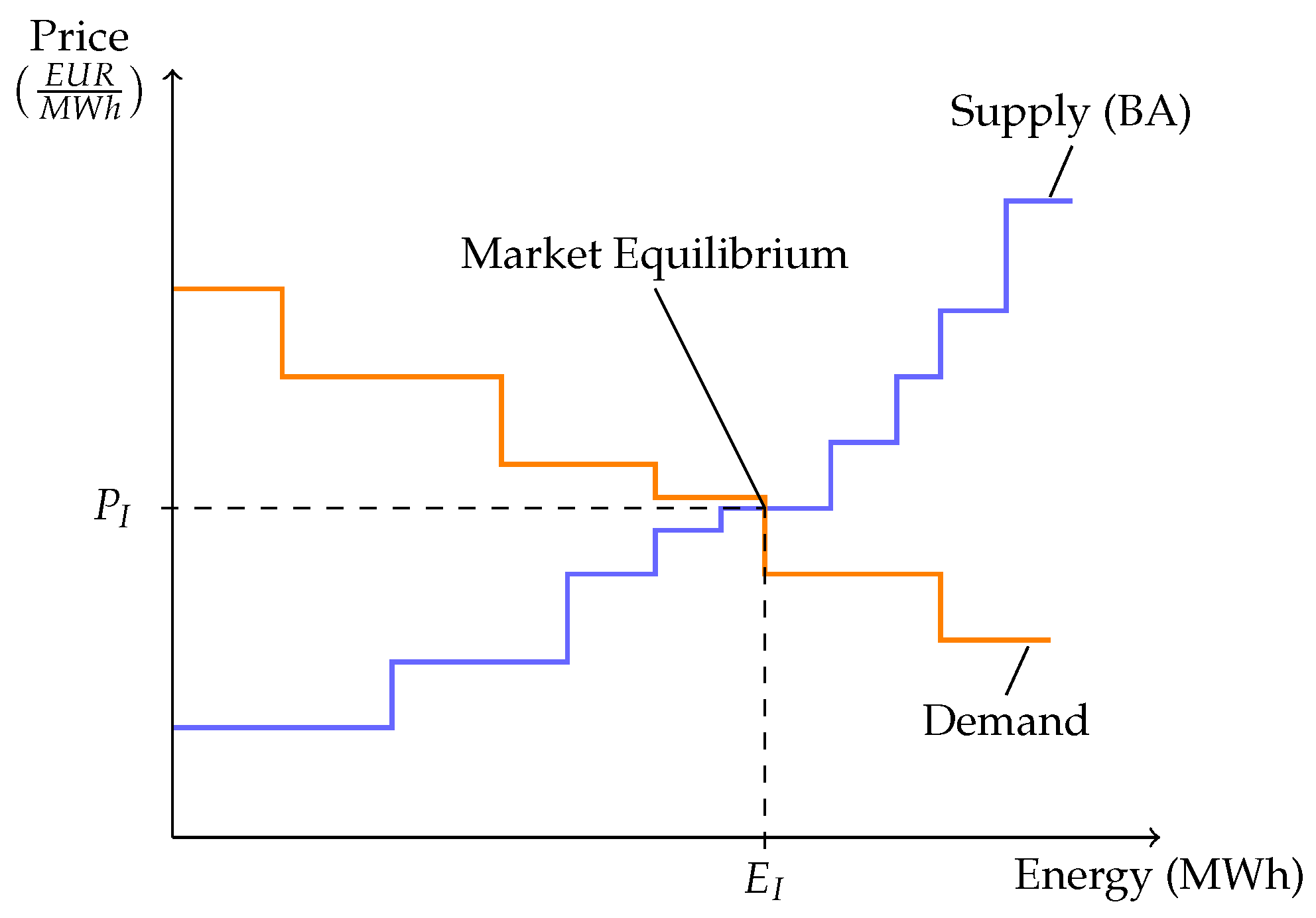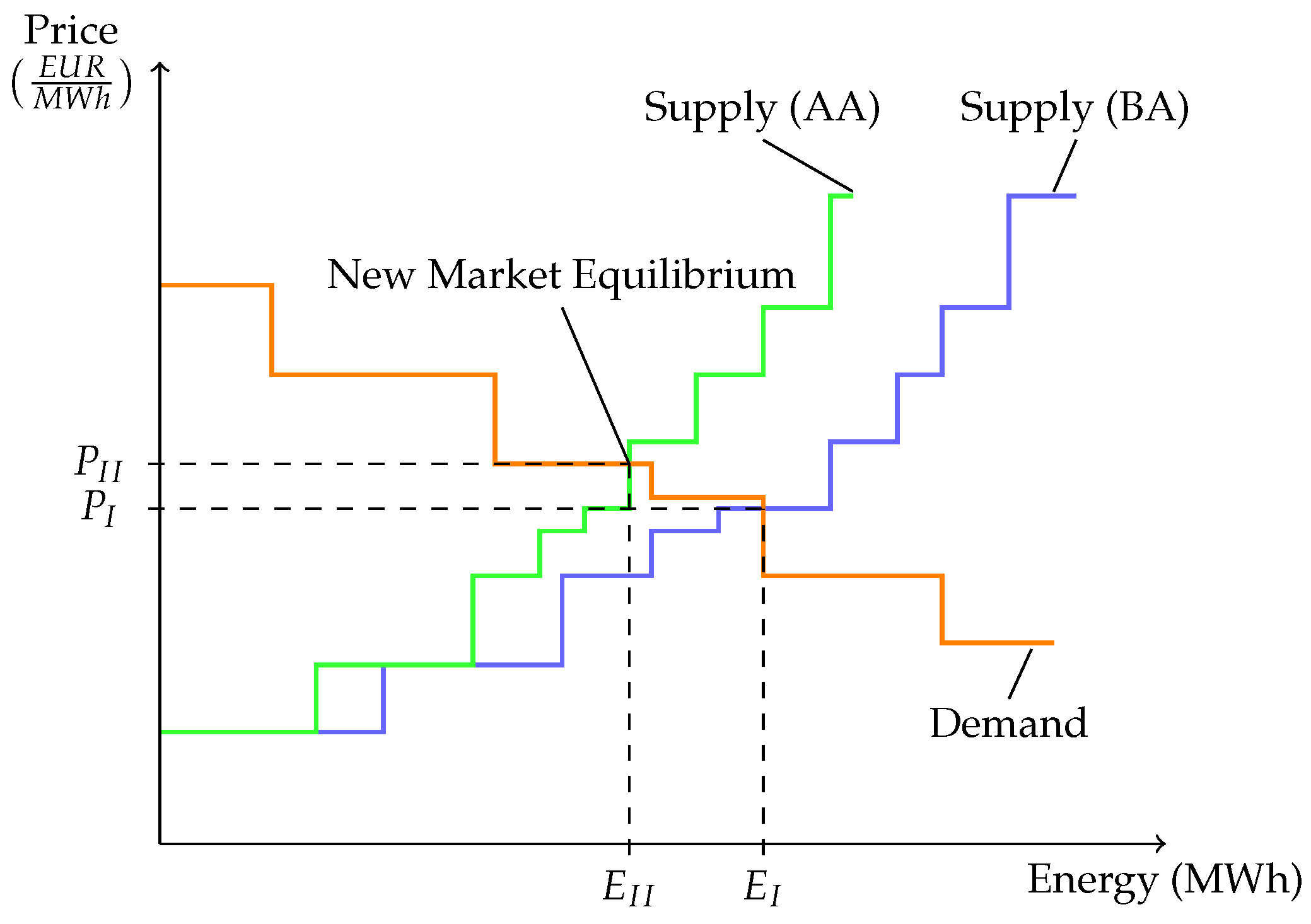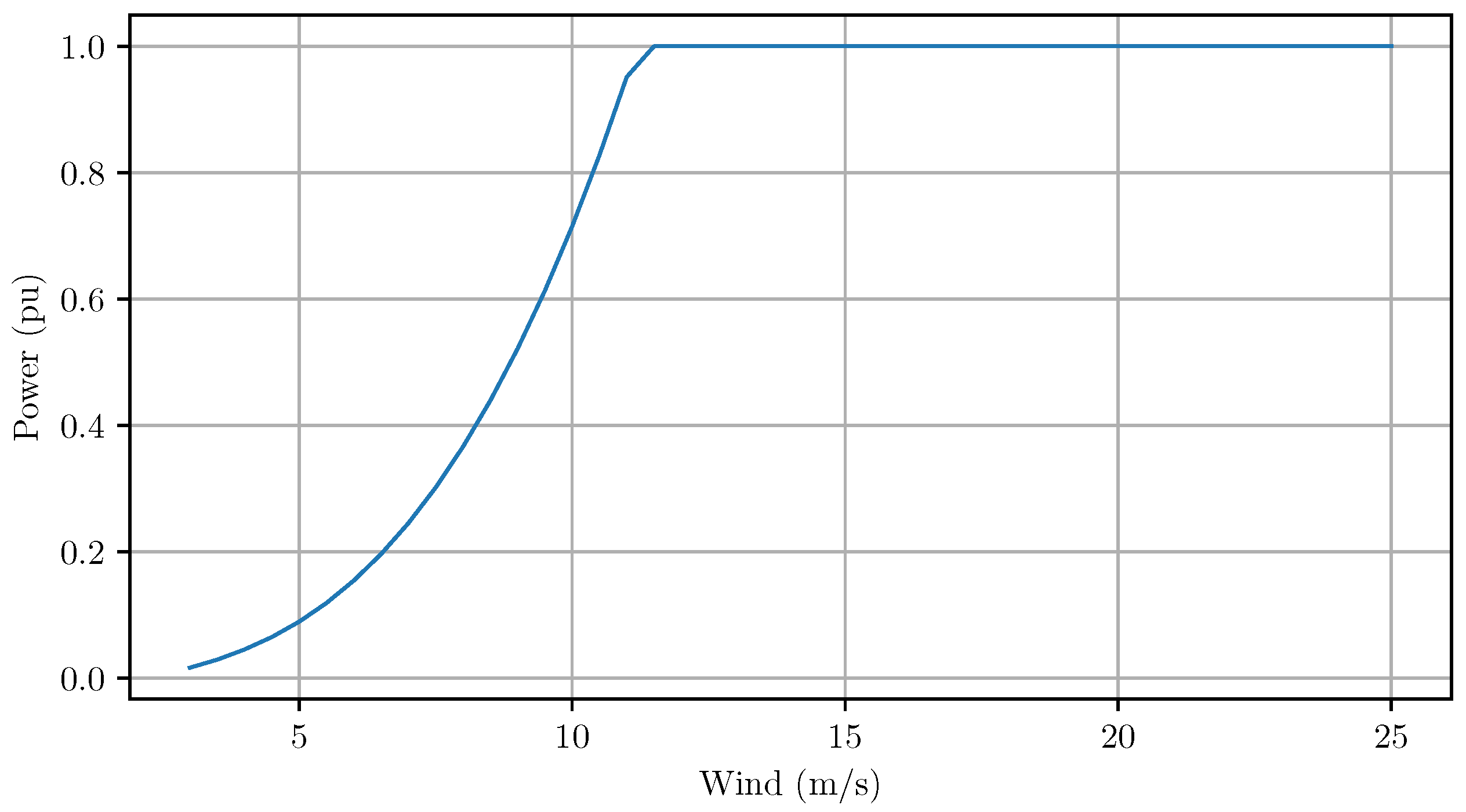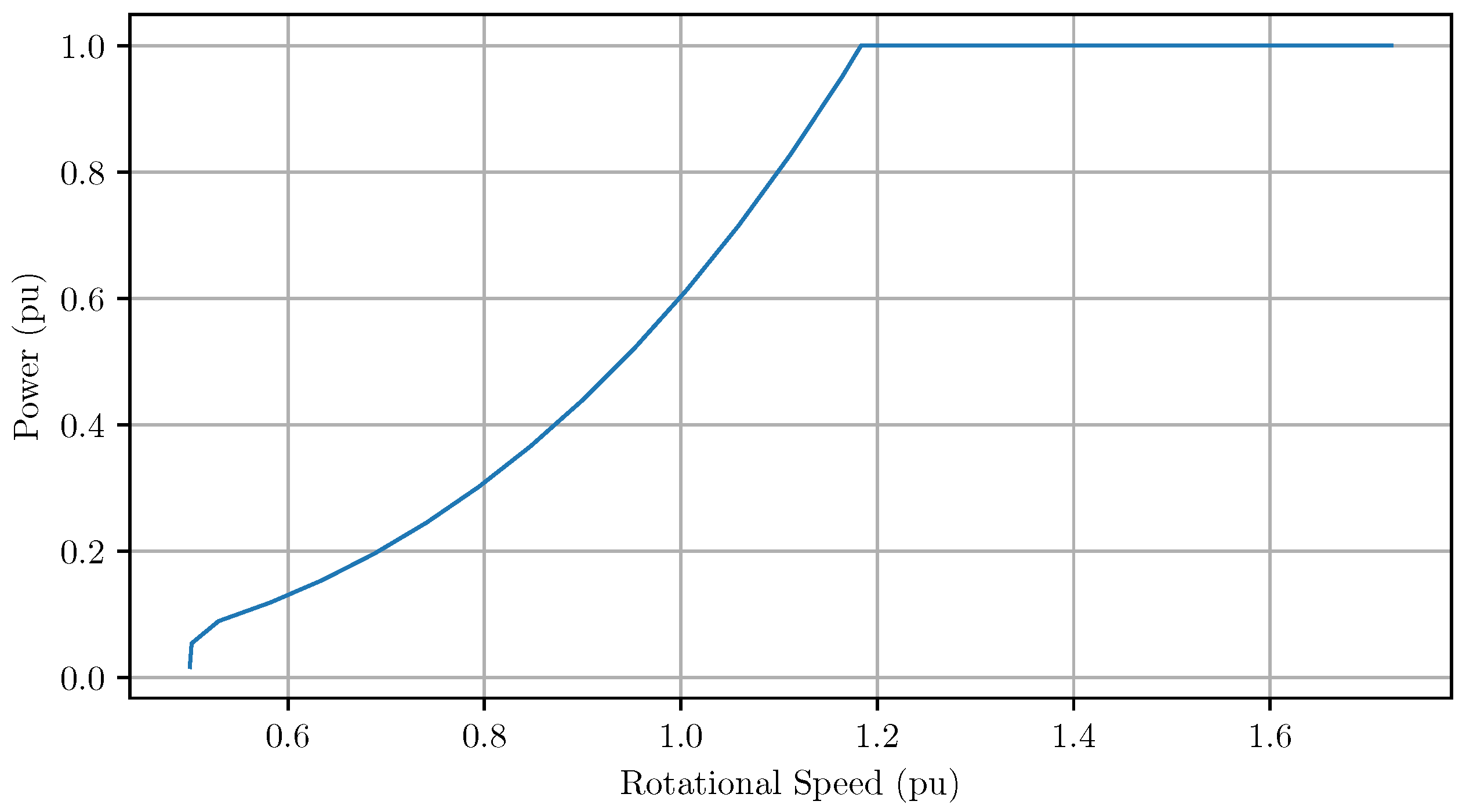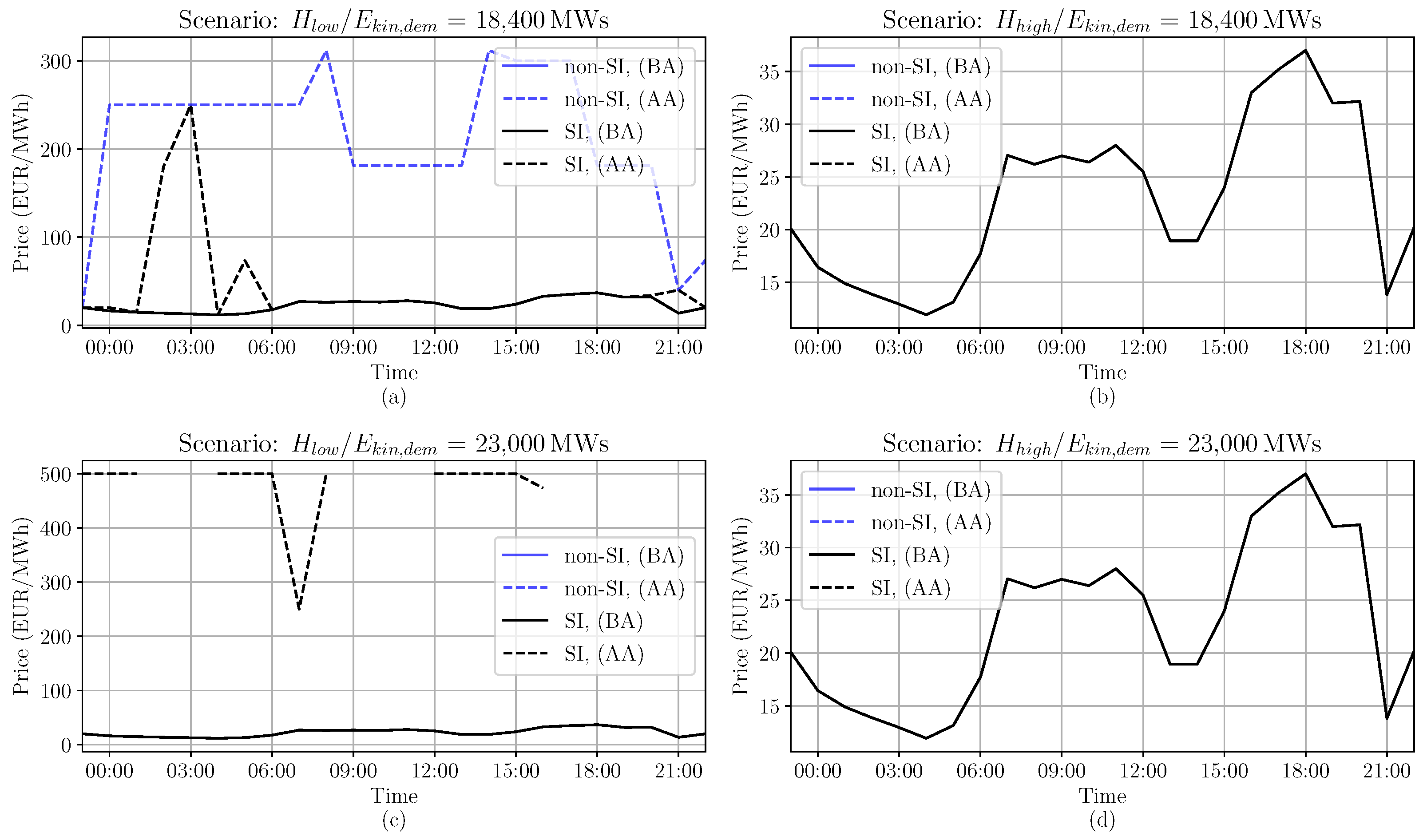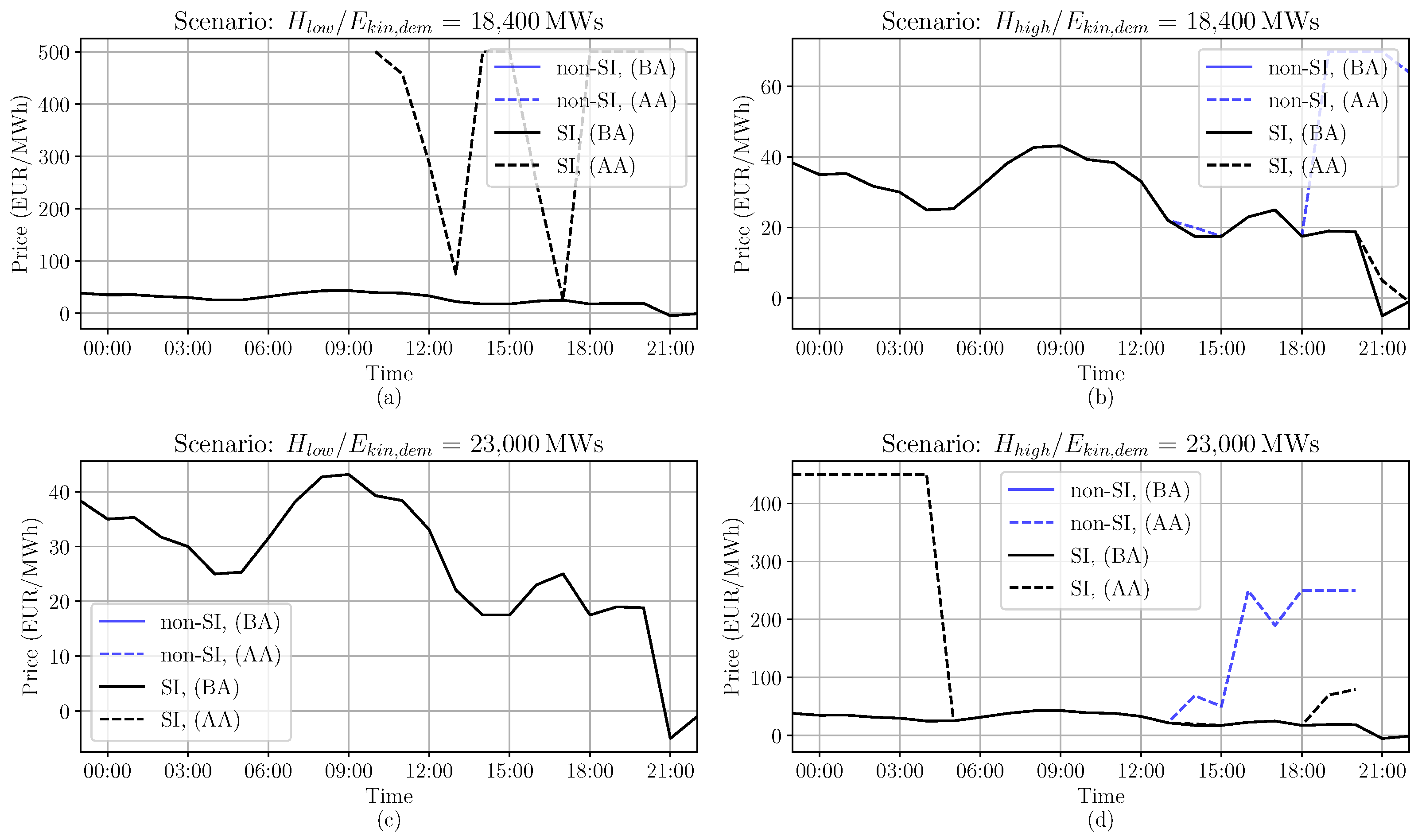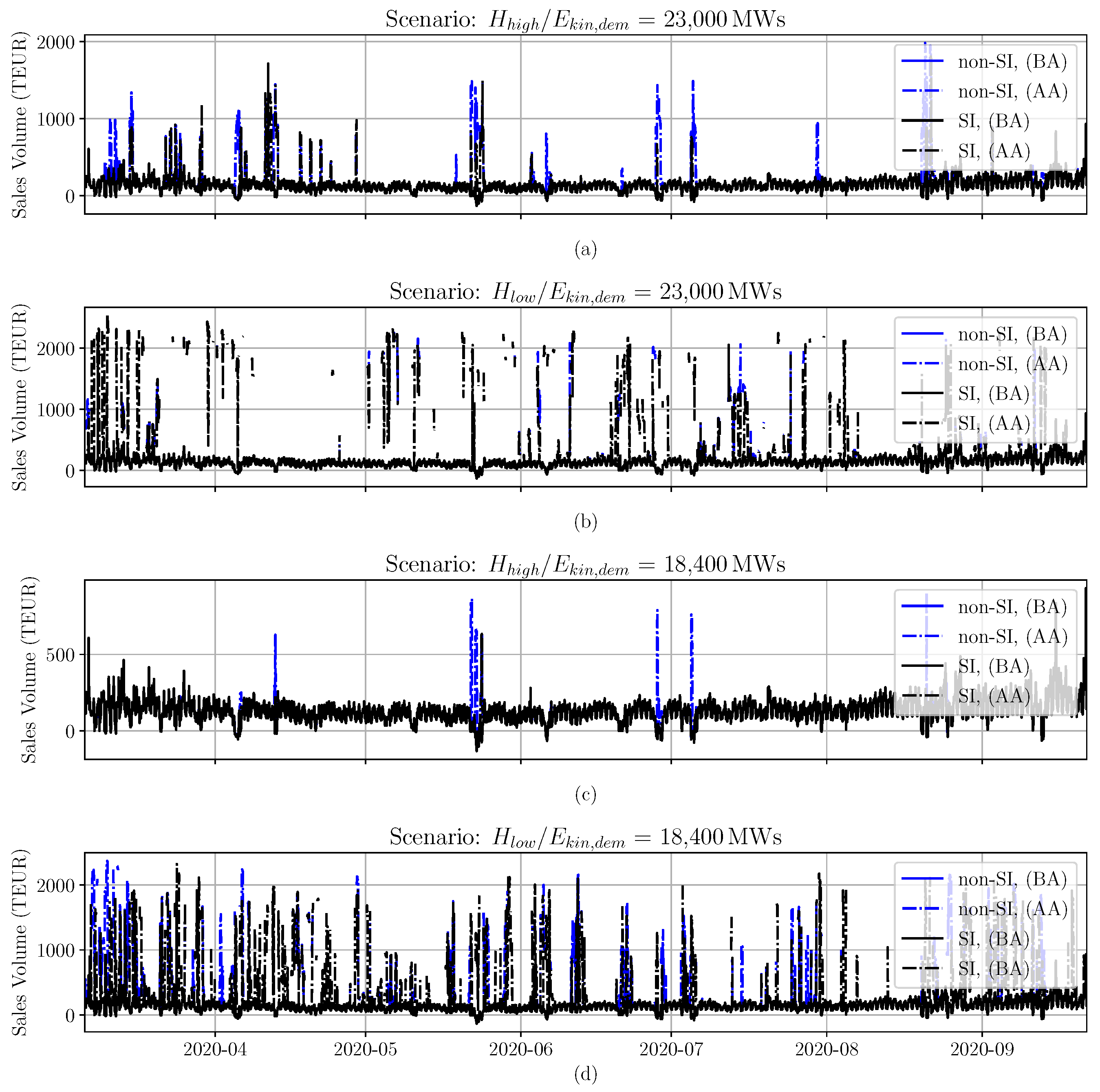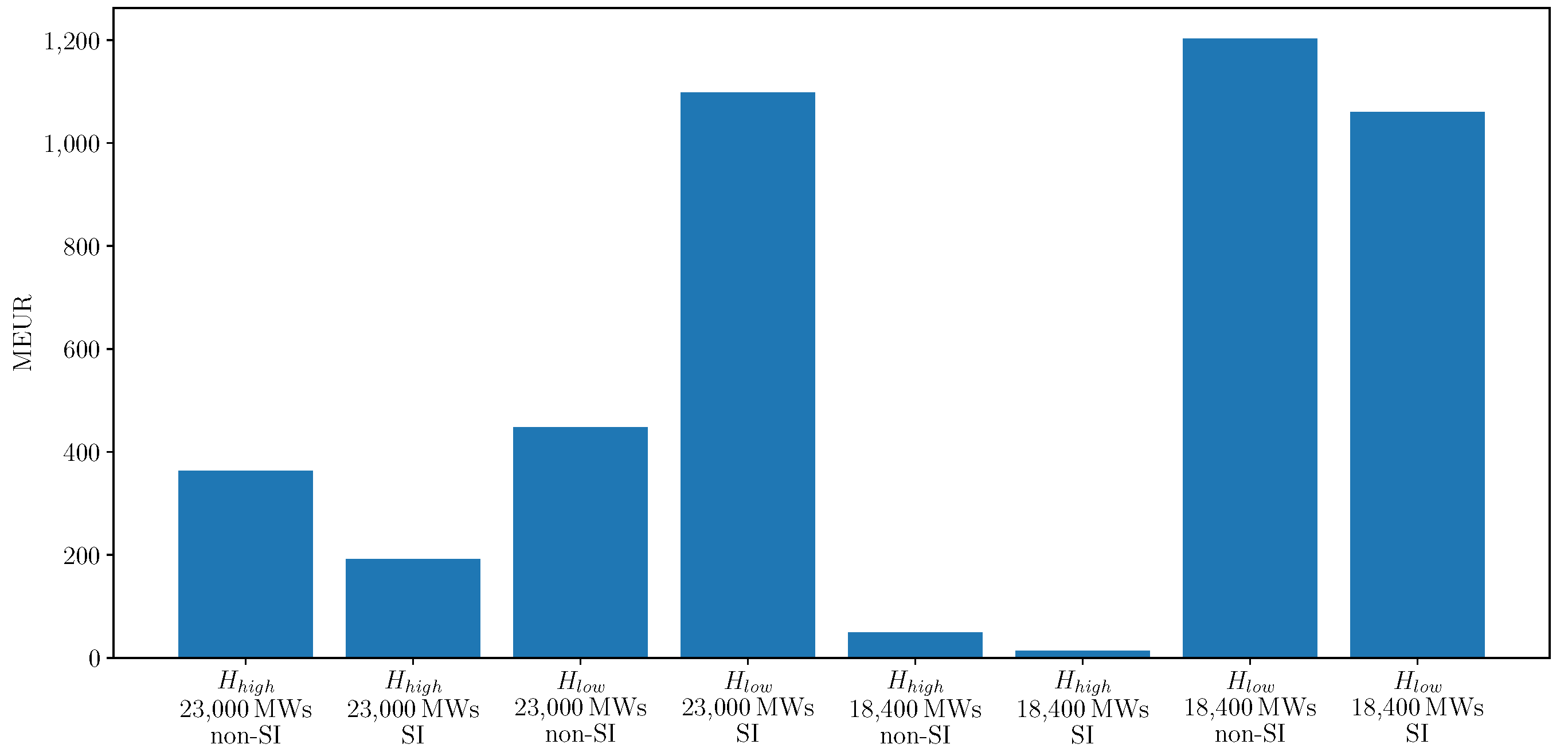1. Introduction
The absolute need to decarbonise energy systems is indisputable. In order to achieve greenhouse gas emission targets, the power system generation mix shifts from a generation mix based on fossil fuel driven generation sources to a mix based on renewable generation sources [
1]. The increasing share of renewable energy sources challenges power system operators and authorities [
1], and power markets [
2]. An important challenge is the maintenance of grid frequency controllability due to decreasing power system inertia [
1].
Power system inertia is an essential, yet passive part of grid frequency control [
1]. The grid frequency itself is the indicator for power balance in AC power systems [
3]. If power supply and power demand, including grid losses, are balanced, the grid frequency is constant [
3]. In case power supply surpasses power demand, the grid frequency increases and vice versa [
3]. The grid frequency is a representation of the rotational speed of all synchronously connected rotating masses in power systems [
3]. The speed with which the grid frequency changes in the event of a power imbalance, commonly known as the rate of change of frequency (ROCOF), is determined by the synchronously connected machines with their rotating masses, i.e., their moments of inertia [
3]. Higher power system inertia decreases the rate with which the grid frequency changes [
1]. If the grid frequency increases, the rotational speed of the synchronously connected machines increases and kinetic energy is stored in the rotational motion [
1]. If the grid frequency decreases, the rotational speed decreases and kinetic energy is released into the grid [
1]. Thereby, the speed with which the grid frequency changes is reduced and units providing grid frequency stability services, like frequency containment reserves, are supplied with sufficient time to adapt their power generation output [
1].
Most synchronously connected machines are synchronous generators of conventional power plants [
1]. Power system inertia is supplied by synchronously connected units of power consumers too [
4]. Due to the replacement of fossil fuel power plants, the number of synchronous generators and thereby the amount of inertia in power systems is decreasing. State of the art wind turbines (WT) and photovoltaic systems are connected to the grid via frequency converters [
1]. Hence, they do not provide an inertia contribution in the event of a power imbalance [
1]. However, WT are able to mimic the behaviour of a synchronous machine in the event of a power imbalance by applying additional control strategies and changing the rotational speed of the WT rotor [
5]. This is commonly known as synthetic inertia (SI) [
1]. A novel approach to provide SI continuously with WT [
6], will be applied in this work.
Some transmission system operator (TSO) already demand generation sources like WT to provide an inertia contribution, e.g., in the event of an under frequency situation [
7]. The Irish power system, meaning the interconnected systems of the Republic of Ireland and Northern Ireland, is characterised by a high share of non-synchronous generation sources, mostly WT [
8]. During certain hours, power generation from renewable sources has to be turned-off or dispatched down for power system security reasons [
8]. Statistics regarding dispatched down generation WT energy is published frequently by the TSO [
9]. Reasons for such measures are localised network reasons (constraints) or system-wide reasons (curtailment), such as high non-synchronous penetration or low power system inertia [
8]. Hence, as the share of renewable generation sources emerges in power systems all around the world, the present all-island Irish power system represents a future state of other systems. As the Republic of Ireland and Northern Ireland are both industrialised countries, research findings can be transferred and applied on larger power systems. Still, the sizes and number of units of the system are perfectly manageable for research purposes.
Inertia is not yet a tradeable commodity nor is it economically researched in detail [
2]. A novel dispatch methodology to secure grid frequency controllability by sufficient power system inertia is introduced in [
10]. This dispatch methodology calculates the amount of inertia based on trading results of the day-ahead spot market [
10]. In the event of insufficient inertia, the most expensive non-inertia supplying unit is replaced by the following unit in the merit order whose bid was previously outside the market balance [
10]. This process is repeated until the necessary quantity of inertia is achieved [
10].
The purpose of the work at hand was to apply a novel inertia dispatch methodology. The methodology determines the lowest day-ahead market dispatch cost solution whilst ensuring a sufficient amount of inertia. Additional inertia due to the application of the methodology can be economically quantified. A further research contribution is the introduction and assessment of SI provided by WT as part of the dispatch solution. Therefore, available day-ahead market data of the single electricity market of the Republic of Ireland and Northern Ireland are used. A period of six months is analysed. The applied methodology results, if necessary due to low power system inertia, in a new market equilibrium. Therefore, the upcoming
Section 2 first reviews system inertia in dispatch modeling publications followed by an introduction to SI provision from WT.
Section 3 describes the researched dispatch methodology functionality and applied data. Results are presented in
Section 4 and discussed in
Section 5.
Section 6 concludes the findings.
4. Results
In total, 4799 trading periods of the Irish day-ahead power market were researched by applying the inertia dispatch methodology. The analysis started on 2020-03-06 and ended on 2020-09-21.
Table 3 sums up the overall results of the dispatch methodology application. Based on the combination of demanded kinetic energy by the TSO and whether inertia contribution from power consumers is applied (
= 23,000 MWs or
= 18,400 MWs), the assumptions of the inertia constant per generator type (
or
) and whether SI contribution is considered or not (SI or non-SI), the number of times where market balance results in insufficient kinetic energy varies significantly (see column
Times of methodology application of
Table 3). The outcome was 133 times up to 4683 times of insufficient inertia. Obviously, a combination of a lower demand for stored kinetic energy (
= 18,400 MWs), a higher assumed generator inertia constant (
) and the application of SI by WT results in significantly fewer times of insufficient power system inertia compared to less beneficial system conditions. For the combination of
= 23,000 MWs,
and no SI contribution by WT, 4683 out of 4799 times the market dispatch results in insufficient stored kinetic energy.
A similar pattern can be observed when considering the number of times the inertia dispatch algorithm is not able to meet the condition of sufficient system kinetic energy. The number of times no solution could be found ranged from 0 for two combinations ( = 18,400 MWs, , non-SI and = 18,400 MWs, , SI) up to 4129 for the combination = 23,000 MWs, and non-SI. Again, a less beneficial combination complicates the process of finding a dispatch solution resulting in sufficient power system inertia.
Figure 8,
Figure 9,
Figure 10 and
Figure 11 depict results of two days on which the inertia dispatch algorithm was applied.
Figure 8 and
Figure 10 both depict the influence of the inertia dispatch methodology of the overall system inertia.
Figure 9 and
Figure 11 both depict the day-ahead market price changes due to application of the inertia dispatch algorithm. Results of a day with a higher average system kinetic energy are shown in
Figure 8 and for the price in
Figure 9, whereas a day with lower average kinetic energy is shown in
Figure 10 and the price for the same day in
Figure 11. Each subplot of the Figures shows a different combination of
and the assumption of the generators inertia constant (
or
). The blue line depicts the scenario where SI by WT is not considered and the black line where SI by WT is integrated. The solid line illustrates the result before application (BA) of the inertia dispatch algorithm and the dotted blue line the result after application (AA) of the algorithm. The green area in
Figure 8 and
Figure 10 within each subplot, depicts the stored kinetic energy provided by units which are not trading on the day-ahead market and the red dotted line the demanded system kinetic energy.
The subplots in
Figure 8 show the resulting stored system kinetic energy over time for one day, in this case the 2020-06-11. The top left subplot depicts the results for the combination
= 18,400 MWs and
. The positive contribution of inertia supplying WT is clearly visible. As the blue line (no SI contribution) is almost steadily below the demanded system kinetic energy, the black line (SI contribution) is above the red dotted line, especially from 5:00 to 19:00. After application of the dispatch algorithm sufficient stored kinetic energy can be achieved for the whole day. This is represented by both dotted lines being above the demanded kinetic energy (red line). The price illustration for the same day and combination is depicted in the top left subplot of
Figure 9. If no SI is provided by WT significantly more inertia needs to be supplied by synchronous generators which is visible by higher prices. As by nature of the inertia dispatch algorithm, the merit order is restructured and synchronous generators are included as long as kinetic energy is needed. The newly added synchronous generator sets the market balance price which is obviously higher, most likely due to higher marginal prices. Price changes when inertia is provided by WT is not as significant. The bottom left subplot of
Figure 8 shows results of the combination
= 23,000 MWs and
. Without applying the inertia dispatch algorithm, the system kinetic energy is below
all day. Applying the inertia dispatch algorithm when inertia is provided by WT, during some hours of the day, the requirement for sufficient system kinetic energy is achieved by the algorithm (see dotted black line). Non-existing parts of the dotted black line indicates that no solution could be achieved by the algorithm. The power price during the hours where the inertia algorithm is successful, is in this scenario indicated by high prices of 500 EUR/MWh. For both remaining subplots in
Figure 8 (top right and bottom right subplot) both combinations result in sufficient stored system kinetic energy for the whole day. Hence, the algorithm is not executed and the power price does not change as visible in the top right and bottom right subplot in
Figure 9.
Figure 10 and
Figure 11 show the results for the 2020-04-12. A day which is characterised by less system inertia compared to the previously explained scenario results. For every combination the inertia dispatch algorithm had to be executed as visible by the dotted lines in the subplots in
Figure 10. No solution was found by the algorithm for the scenario
= 23,000 MWs and
as visible in the bottom left subplot. Again, it is visible that SI of WT is able to provide a significant amount of kinetic energy to the overall system kinetic energy. This is particularly during the second half of the day.
Figure 11 shows the power price changes due to insufficient inertia. In some hours the price increases significantly. See top left subplot at 10:00, 14:00, 15:00 and hours from 18:00 onward and the first hours of the day until 04:00 in the bottom right subplot. As no solution was found by the algorithm for the combination
= 23,000 MWs and
(bottom left subplot), only the power prices before application of the algorithm are illustrated.
Figure 12 shows the sales volume over time for each trading period of the analysed time series. The sales volume for each trading period is calculated by multiplying the traded volume and the power market price.
Figure 12 is split into four subplots. Each of the four subplots shows a combination possibility of
= 18,400 MWs,
= 23,000 MWs,
and
. A single subplot depicts the sales volume with (black graph) and without (blue graph) SI provided by WT before (BA) and after application (AA) of the algorithm. For each combination, the sales volume is in the range of 0 TEUR to 2500 TEUR. The combination
= 18,400 MWs and
leads to the scenario were the algorithm is activated the least times compared to the other scenarios, whereas the combinations
= 18,400 MWs and
leads to the highest times of algorithm activation. Further, the y-axis labels for the combination
= 18,400 MWs and
ranges only from 0 TEUR to 750 TEUR.
Figure 13 shows the accumulated sums of the sales volume for each scenario. Each bar illustrates a single scenario. Except for the scenario
= 23,000 MWs and
the positive influence of SI from WT on the overall lower sales volume is visible. The overall sales volume if SI is provided by WT is, except for one combination, significantly lower. The likely explanation for the one exception is the the high number of times where the algorithm was not able to find a solution to meet the condition of sufficient system kinetic energy. Visible as well, is the fact that the assumption of higher generator inertia constants leads to fewer activation of the algorithm and hence to lower total sales volumes.
It is already determined that the future trading unit for the commodity inertia should be EUR/kgm
2 (or any other currency), whereas kgm
2 is the unit of the moment of inertia (
J) of a synchronously connected machine [
2]. By rearranging
where
is the system-wide stored kinetic energy,
being the overall moment of inertia and
is the nominal grid frequency of 50 Hz as in the case of the AC power system of Ireland, the overall moment of inertia can be calculated to assess the additional costs for the additionally supplied inertia. The fourth column of
Table 3 shows the calculated results, which represent average values for the researched time period. With respect to the additionally supplied inertia, the costs for inertia range from 1.02 EUR/kgm
2 to 4.49 EUR/kgm
2. The calculated results are in the same order of magnitude as previous research indicate [
2].
5. Discussion
To secure power system stability, the Irish TSO has defined objectives of various operational constraints, one being the operational limit for inertia [
26]. Based thereon is the research presented in the work at hand. Comparing the results presented in
Table 3 and the times where the inertia dispatch algorithm is applied and the
All Island Quarterly Wind Dispatch Down Report 2020 (Qtr. 3) there is a obvious abnormality [
9]. The published statistics [
9] indicate the dispatched down energy by WT listed for each curtailment category for each month.
Table 3 lists the absolute number of times the inertia dispatch methodology is applied for the different combinations. Even though the numbers are not directly comparable, it is obvious that the dispatch algorithm tends to overestimate the times of insufficient inertia in the power system.
One explanation is that the research was carried out with only publicly available data. The TSO and the market operators publish various information. Still, the results indicate that not all information which would lift the amount of stored kinetic energy in the power system up are obtainable. For example, power plants connected to the power system but only used for self consumption—e.g., the case of steel mills. Small units not trading on the market and connected to the distribution grid are not listed by the transparency platform of the ENTSO-E. Though, if equipped with a synchronous generator, the units contribute to the overall power system inertia. Second, the assumed inertia constant per fuel type (
Table 2) is crucial to estimating the overall power system inertia.
Table 3 indicates a huge gap comparing the scenarios applying
and the scenarios applying
. The times where the dispatch methodology was applied increased significantly when the lower inertia constant bound (
) was used. It is safe to assume that the scenarios applying the lower bound of the inertia constant range (
) underestimate the power system inertia constant clearly. Hence, it can be assumed that the actual inertia constant of the Irish generation units is close to the upper bound values or even above. The same pattern, as described before, is visible, where the application of the methodology results in no solution. The results of the scenarios with the
assumptions are rather unreasonable.
Figure 9 and
Figure 11 illustrate a pattern which is visible throughout most of the results. Even a marginal increase of the power system inertia, due to the restructuring of the merit order by the inertia dispatch algorithm, results in significant price increases up to 250 EUR/MWh and beyond. It can be assumed that applying the inertia dispatch algorithm in reality, the biding structure of power plant operators would change. More power plant operators would tend to bid, as due to the possibility of low power system inertia and the perspective of the application of the inertia dispatch algorithm, their bids would be accepted. This scenario is likely to result in more power selling bids and lower price bids. Unfortunately, this cannot be simulated in this study, as the research at hand relies on actual power market data and no generic literature cost data is used. The bidding behavior of market participants under new market rules is not within the focus of this work.
A new bidding behavior of market participants would also decrease the number of times the algorithm would not be able to find a solution. Finding no solution to the problem formulation is obviously worst of all outcomes as the problem of insufficient power system inertia remains to be solved by the TSO. Hence, the TSO has to activate other sources providing inertia—for example, decommissioned power plants, which are most likely decommissioned for safety or economical reasons, which ultimately increase overall system costs; or storage units providing inertia, such as flywheels. Previous research indicates that storage units solely used for the provision of inertia are vastly expensive [
2]. Comparing the costs for additional inertia from
Table 3 with results from [
2] shows that the application of the dispatch methodology and temporarily price increases are overall less expensive than securing sufficient inertia by storage unit solutions. Still, a single market for power system inertia has to be developed and should decreases costs for inertia in power systems [
33].
6. Conclusions
This study applied and assessed a novel dispatch methodology of the day-ahead market to secure sufficient inertia in power systems and researched the influence of SI provided by WT on power prices. The methodology allows to determine costs per additionally supplied inertia. This work applied actual data provided by the day-ahead market operator of the combined power market of the Republic of Ireland and Northern Ireland, and data from the TSO and the ENSTO-E. Eight scenarios were designed which cover different inertia constants per fuel type, two operation limits of stored kinetic energy and the application of SI provided by WT.
If basic market operation without application of the inertia market methodology results in an insufficient level of stored kinetic energy, the arranged sell bids of the day-ahead market are restructured. With respect to the researched scenario, SI is either part of the process or is not. In decreasing price order, sell bids of units not providing inertia get replaced by the following unit in the merit order. This iterative process is repeated until a level of sufficient inertia is achieved, and then it continues in the next trading period. Trading periods where a sufficient amount of kinetic energy cannot be realised by the algorithm occur.
Overall, a six month period with a total of 4799 trading periods was researched. Based on the combination, the results differ significantly and the prices on the day-ahead market increase significantly too. Applying SI provided by WT decreases costs and the number of times the inertia dispatch methodology is applied. Naturally, a scenario with a lower operational limit for inertia, higher assumed inertia constants for generation units and inertia support from WT, results in fewer applications of the inertia dispatch algorithm and lower costs for the additionally supplied inertia, compared to a scenario with a higher operational limit for inertia and/or lower assumptions of inertia constants for different generation units. The average cost per additionally supplied inertia ranges from 1.02 to 4.49 EUR/kgm2.
The inertia dispatch methodology assessed in this work is a useful approach with which to secure a sufficient amount of inertia in power systems. However, it has limitations, and the results clearly indicate that the provision of power system inertia in future power systems has to be decoupled from the power market, because market prices resulting from the inertia dispatch algorithm are too high. Future research has to assess whether a single market for trading inertia is capable of providing sufficient inertia to secure grid frequency controllability at reasonable system costs [
2,
33]. Similar to markets for primary frequency control (where power is traded) or capacity markets, the provision of inertia for a certain time period would be traded, rather than the actual utilisation of the system’s service inertia [
2]. As inertia is a non-traded commodity and its costs have so far been researched only superficially, the results determined in this work can be seen as an indicator for future prices on such a market for the provision of inertia.
